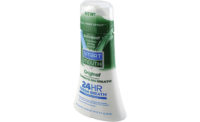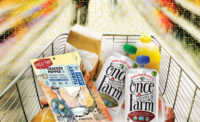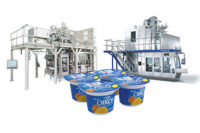A successful package is one that meets consumer demand and can adapt to changing trends. The package should also address concerns and demands from suppliers and consumers alike. One such demand that is consistently on consumers’ minds is convenience. We all want our packaging to be easy to carry, store and open. Bags and pouches seem to master these wants, while being aesthetically pleasing, delivering a winning package to all. In 2013, the U.S. flexible packaging industry grew 2.8% to $27.2 billion in annual sales and the 2014 forecasted growth is 3.8% to $28.2 billion. According to the Flexible Packaging Association, the flexible packaging industry continues as one of the fastest growing packaging segments in the U.S.
Wine, baby food and a more recent trend, soup, has been introduced in flexible formats, breaking the rigid mold that once ruled these segments. And now, more and more pet food, cereal and snack foods are continuing to become available in pouches and bags, proving that the future of packaging is going to have to be more flexible.
The new wave of snacking
Today we all want convenience in our daily lives and snacking is no exception. Snack food packaging must be convenient. We eat our snacks in our cars, on the subway, at work, walking down the street and just about anywhere except the kitchen table. And it seems these days we can get our favorite food items in handy little single-serve packaging to accommodate our on-the-go lifestyle. Kellogg’s is now capitalizing on this trend but turning our morning favorite into an all-day snack. The company is now promoting their cereal (four varieties) as a snack option in portable snack packs. Kellogg’s On the Go Fun cereal pouches are 1-ounce bags of cereal, and just some of the many new products that the company will create in snack packs. In addition to cereals, Kellogg brands will debut cookies, crackers, salty snacks, frozen breakfast options and snack bars.
|
Effectively coding flexible pouches As more beverage manufacturers follow the trend to flexible pouches, they are finding a range of thermal transfer overprinting (TTO) solutions to meet their coding needs. Printing simple dates and time codes as well as more complex ingredient and marketing information on pouch substrates can be achieved with TTO’s high clarity at production line speeds. The thermal transfer printing process applies high resolution text and images onto flexible film by using a thermal printhead and thermal ribbon. Some thermal transfer printheads can be retracted up to 4.5mm to ensure virtually all resealable pouch types can be coded with ease. This makes TTO a simple choice for today’s food and beverage manufacturers as they strive to meet current packaging trends and keep lines running seamlessly. High quality packaging demands high quality codes Food manufacturers that aim to maximize product packaging artwork for marketing and promotional purposes can benefit from TTO solutions that can print up to 300 dpi (12 dots/mm). Offering exceptional graphics and text capabilities, the print quality offered by TTO is ideal for finely printed nutritional and ingredient statements. By printing high quality information inline directly on the package substrate, manufacturers can realize a reduction in preprinted film inventory and line changeovers. Selecting the right coding solution can make keeping up with packaging trends easier. With its ability to code on flexible applications, including form, fill and seal, TTO is an excellent choice throughout beverage manufacturers’ and packagers’ facilities. |
Just this year Ampac unveiled a pouch in a less than traditional shape for the single-serve snack market. The new E-Z SnackPak™ is a tetrahedron shaped pouch that transforms into a serving tray upon opening – providing a unique, fun and clean consumer experience (i.e. no more messy hands from greasy potato chips). The pouch is designed to be easy to open by pinching and pulling open at the top, transforming it into a perfect tray. In addition, the E-Z SnackPak pouch uses 15-25% less material than traditional snack food packaging.
Sal Pellingra, Ampac’s VP of Innovation and Technology says, “This unique and innovative package is a true differentiator and transforms the traditional snacking experience into a consumer delighter. Its shape, ease of opening and transformation into a serving tray, displays creative functionality and supports on-the-go lifestyles.”
The package’s resounding feature is that it opens up into a tray. The E-Z SnackPak pouch can be used in applications including sweet and savory snacks, treats and dry foods. It is great for lunches, fast food restaurants and bars, and is ideal for sharing. The snack packs are filled on a pre-made pouch filling machine. The packages are offered in clear (non barrier), opaque, clear barrier and metallized opp (moderate to ultra high barrier) for just about any application.
Is this the shape of things to come? Pellingra says that he is seeing innovations and improvements in flexible packaging that not only reduce materials used, but also offer consumers useful and appealing features.
“Flexible packaging is pushing the boundaries for more improvements,” he says.
And more than just clever, the package protects the content inside. The tetrahedron shape with built in head space adds package support which provides product protection during shipping and handling. According to Pellingra, the package design was initially developed for herbs because the traditional pillow shape used in packaging herbs was damaging its contents. The shape worked so well to protect the herbs, combined with the easy open tray feature; it was deemed an ideal choice for snack foods.
Sometimes it’s hip to be square
Another company has released a new package in a unique shape, a square. Mondi Americas’ new Square Bag can support a variety of applications, like food, wine and pet food. The Square Bag is constructed of advanced barrier films in multiple layers. It securely packages powders and granular materials weighing up to 10 pounds and liquids up to 1.5 gallons.
The Square Bag can be customized to accommodate many applications. It can be fitted with a spout, zipper, slider or hook and loop opening, with label handles on different panels. The bag can carry graphics and product information on all six panels and each panel can be made with up to three different film materials.
Packaging is becoming more unique and cleverer to really capture consumers as they fill their weekly grocery baskets.
“Many consumer goods packagers today are thinking outside the traditional cardboard box, hard plastic container and glass bottle,” says Kevin Young, president, Mondi Americas. “Mondi’s Square Bag offers these packagers an appealing alternative to conventional packages. It provides clear advantages in terms of attractiveness, shelf impact and ease of filling.”
|
Want more insight into pouches? If you answered yes, consider attending Global Pouch West December 3-4 in Garden Cove, CA. The conference is the second focused on flexible packaging and pouches, and builds on the success of June’s Global Pouch Forum. Among the sessions will be a case study in branding from Seattle’s Best Coffee and its advertising firm; what’s new in pouch convenience; advances in bio-based films; and active and intelligent innovations. This year’s keynote speaker is Karl Linck, VP of engineering at Sargento and he will be telling the Sargento story. Sargento Foods Inc. is an old-line company that does not have old-line thinking when it comes to packaging. The Wisconsin cheese company—number 2 in the U.S. for sliced cheese—was one of the first to get cheese out from behind the deli counter and onto grocery store shelves. It started packaging with flexible—cellophane—back in the 1950s and pioneered the use of zippers with plastic film. Go to globalpouchwest.com for information about the agenda, registration and the networking reception and exhibition. |
Like all flexible packaging, the Square Bag is lighter and less bulky than rigid packaging materials. Young notes that the bags take up less space on pallets and trucks, potentially reducing transportation and storage costs.
The Square Bag (shown here in a pet food application) is one of many flexible formats being used in the pet food market. According to the Pet Food Packaging study from The Freedonia Group, US demand for pet food packaging is expected to rise 4.8% annually to $2.5 billion in 2018, especially those packaged in flexible formats. Freedonia analyst Joe Pryweller says, “Plastic pouches will be the primary beneficiary of the trend toward more advanced pet food packaging. Pouch demand in pet food packaging will rise 8.3 percent per year to $540 million in 2018, the fastest pace of growth among pet food packaging types.”
Scour the grocery store shelves to see many of our favorite foods (and beverages) being offered in flexible formats. Aside from the practical reasons suppliers and consumers enjoy these lightweight and unbreakable packages, pouches and bags are proving to be convenient, functional and fun. New innovations and improvements to the segment are really breaking the traditional package mold, offering convenience and usefulness combined with fun and attractiveness that make for a successful package hands down.







